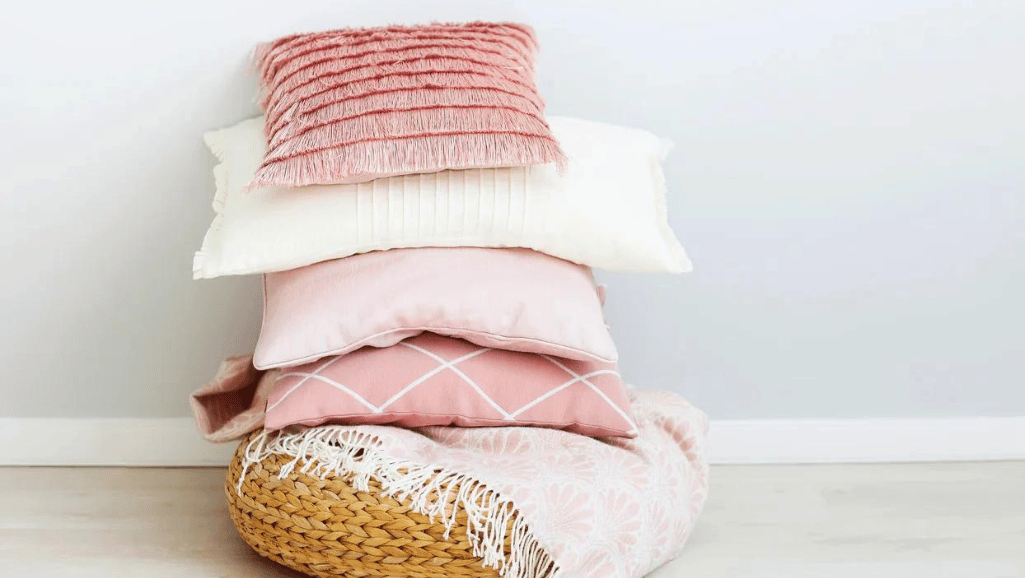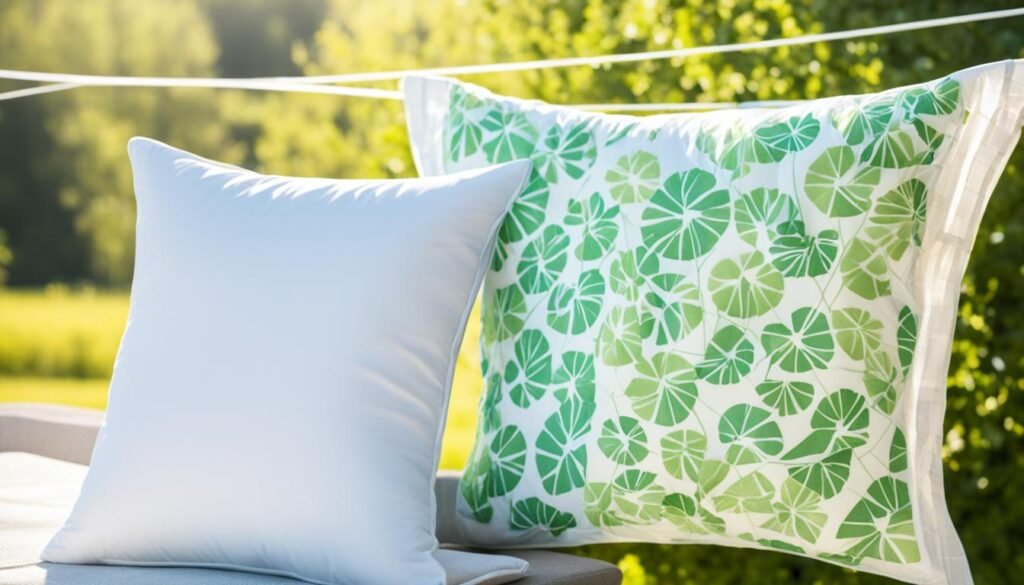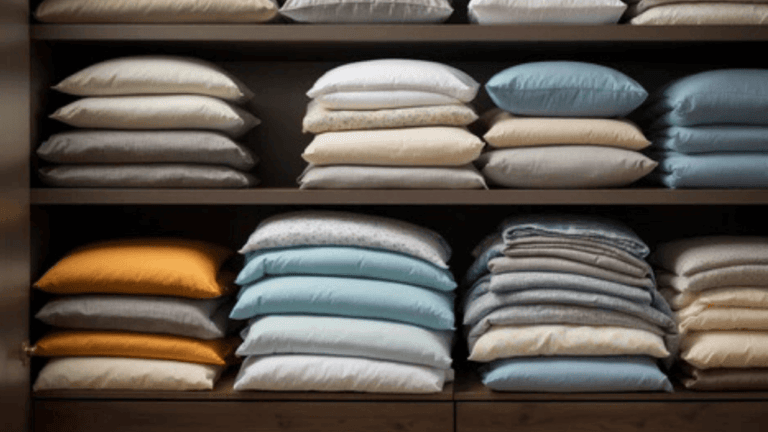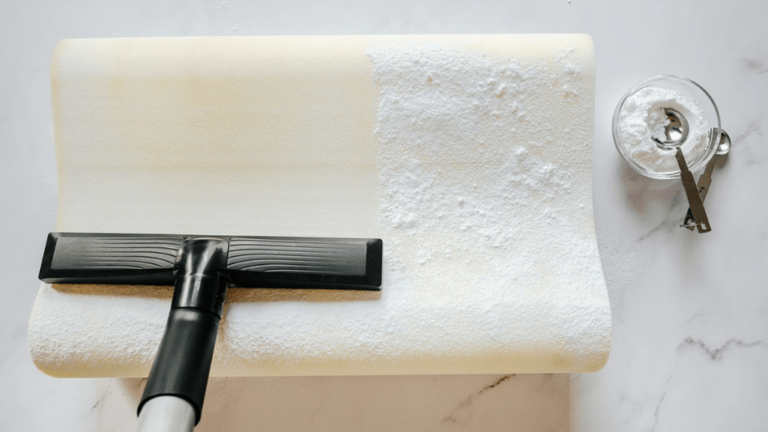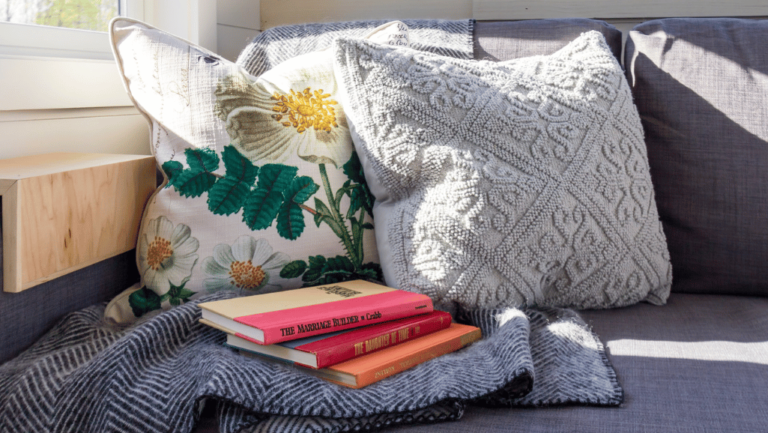Pillows are key for a good night’s sleep. They pick up dirt, sweat, and sometimes mold. So, we need to wash and dry them often. This keeps them clean and comfy.
To dry pillows right, you need a few things. For example, a scrub brush, dryer balls, laundry detergent, and maybe some stuff to remove stains. You should also look at what the tags say. This tells you the best way to clean them.
It’s super important to dry pillows fully. This stops mold and mites. Dryer balls help keep everything fluffy. Remember, pillows should dry in 45-65 minute turns. They must be totally dry to stop bacteria.
Key Takeaways
- 31 of the Best Pillows of 2024 were tested, with 13 identified as the most comfortable.
- Pillows should be replaced every two years for optimal performance and hygiene.
- Regular pillow protectors should be machine-washed in hot water once a month.
- Add dryer balls or tennis balls to the dryer to prevent filling clumps and promote fluffiness.
- Avoid drying memory foam, latex, and silk pillows in the dryer; opt for air-drying instead.
Understanding the Importance of Drying Pillows Properly
It’s key to dry pillows right for keeping them clean and fresh. If you dry them the wrong way, you might get bacteria, mold, or mites. These things like to grow in wet places.
The Consequences of Improper Drying
Not drying pillows enough can bring bad results. It can make mold and bacteria grow, making a bad smell. Plus, if not dried well, pillows get lumpy and lose their fluffiness. This makes sleep less comfy. Care for pillows as instructions say to avoid these problems.
Benefits of Proper Pillow Maintenance
Keeping pillows clean and dry makes them last longer and stay cozy. Aim to clean pillows every few months. And when drying, choose a low heat on the dryer. Dryer balls can be great help, keeping pillows from getting flat. They also keep the insides evenly spread.
Some extra steps can also help. Fluff your pillows daily by giving them a good shake. Toss them in the dryer with a bit of vinegar, but skip the heat, every now and then. Using pillow protectors cuts down on how often you need to wash them. This means more sleep with fresh, comfy pillows.
Don’t forget, you need to change pillows every two years. This is very important for your sleep and health. If your pillows start to smell or stain, even after washing, it’s time for new ones. Doing the right drying and care steps can make your pillows last longer and keep you comfy at night.
| Pillow Type | Recommended Care | Replacement Frequency |
|---|---|---|
| Down | Low heat dryer, fluff with dryer balls or tennis balls | Every 2 years |
| Synthetic | Low heat dryer, ensure thorough drying | Every 2 years |
| Memory Foam | Air dry, avoid direct sunlight, vacuum if necessary | Every 2 years |
Pillow Drying Methods: An Overview
Knowing how to dry pillows right helps them stay comfy and last longer. There are two main ways to dry pillows: by machine or by air. It’s important to dry them well without hurting their shape.
Machine Drying
Drying pillows in a machine is great for ones with polyester or down. Use a low or no-heat setting to keep fibers strong. Throw in dryer balls to stop them from clumping and to help keep pillows soft and fluffy.
Avoid using auto-dry settings. They might not dry the pillow fill fully. This could lead to mold growth, which is bad for your health.
Air Drying
Air drying works best for memory foam and latex pillows that can’t take heat. Make sure there’s good air circulation and fluff them now and then. This helps all parts of the pillow dry evenly.
For memory foam, vacuum it first and only wash spots if you must. Keep latex pillows out of direct sunlight to keep them soft.
To air dry well, turn the pillows and put them in places with fresh air. This speeds up the drying process.
| Pillow Type | Drying Method | Special Instructions |
|---|---|---|
| Down | Machine Drying | Use dryer balls; Low heat |
| Polyester | Machine Drying | Fast drying; Low heat |
| Memory Foam | Air Drying | Away from heat; Periodic fluffing |
| Latex | Air Drying | Avoid sunlight; Rotate frequently |
How to Dry Pillows Using a Dryer
Drying pillows in a dryer carefully is key to keeping them cozy and lasting longer. Start by gently squeezing out extra water after washing. This step avoids overloading your dryer. Always choose a low or no heat setting, especially for down or feather pillows. High heat can damage them.
Set your drying time in small chunks, like 45-65 minutes each, and fluff and turn your pillows regularly. Doing this makes sure the filling spreads out well, helping your pillows dry faster. Adding dryer or tennis balls stops clumps and keeps your pillows fluffy.
Remember, the way you dry your pillows depends on what they’re made of. Never put memory foam, latex, or silk pillows in the dryer; it could ruin them. Always check the care label. Drying time for pillows varies, but they usually take 30-60 minutes.
When the drying is done, let the pillows cool and do a touch test. They should be completely dry. If not, they need more time in the dryer. This step prevents mold and mildew.
Don’t rely on the auto-dry setting. It might not dry the pillows the right way. Following these steps will keep your pillows in great shape for a long time.
Best Practices for Drying Different Pillow Types
It’s key to dry your pillows right to keep them comfy and lasting longer. Different types like feather, down, memory foam, latex, or synthetic need special care. This is to keep their shape and hygiene in check.
Feather and Down Pillows
Feather and down pillows should be dried carefully for a longer life. Don’t use heat; choose an air-dry setting or let them dry naturally with tennis balls to stop clumps. Fluff and turn them often. This makes sure the feathers spread evenly, keeping it comfy without lumps.
Memory Foam and Latex Pillows
Memory foam and latex pillows should never meet a dryer’s heat. It can harm their shape. Instead, air-dry them gently and carefully get rid of extra water. Keep them in a well-ventilated place and turn them now and then. They should lie flat, not hang, to avoid changing their shape.
Synthetic Pillows
Pillows with polyester can go in the dryer, but gentleness is key. Choose a low-heat setting to save the fibers from damage. Dryer balls help maintain fluff and evenness. Always check the care label for special drying tips.
- Size of the pillow: Queen and king size pillows might be too big for regular machines.
- Drying guidelines: Use tennis balls for feather pillows and a low heat with dryer balls for synthetic ones.
- Importance of care labels: Always look at the care label to prevent harm.
Knowing the right pillow drying methods and how to dry pillows is crucial. It keeps your pillows fluffy and lasting longer, ensuring a better sleep every night. With the correct tips for drying pillows at home, you can improve your sleep quality with cozy, supportive pillows.
Tips for Drying Pillows at Home
Knowing the top pillow drying techniques is key for good keeping. First, after washing, dry your pillows quick to avoid mildew. Use a low heat in the dryer to protect the fibers. Add a few dryer balls to stop clumping and help with even drying.
- Recommended drying time per cycle is 45-60 minutes.
- Low heat setting is advised to prevent pillow fibers from breaking down.
- Use dryer balls or tennis balls to prevent filling from clumping.
To speed up drying, fluff and turn your pillow every hour or two. Be careful with memory foam pillows. They shouldn’t go in the dryer. Instead, flip them often for the same drying. Always make sure your pillows are fully dry to avoid bacteria and mildew.
Drying two pillows at once helps keep the machine steady. Also, drying on a sunny, dry day, inside or outside, is great. It improves the air and speeds up the process. Here’s a quick look at what to remember:
| Factor | Recommendation |
|---|---|
| Drying Time Per Cycle | 45-60 minutes |
| Dryer Setting | Low Heat |
| Use of Dryer Balls | Yes, to prevent clumping |
| Memory Foam Pillows | No dryer; air dry and flip frequently |
| Even Drying Check | Every 20-30 minutes |
By following these pillow care instructions, you can make your pillows last longer. This keeps them comfy and ensures a good night’s sleep.
Using Dryer Balls: A Step-by-Step Guide
Using dryer balls in your pillow drying routine makes the whole process better and faster. They are good for the environment and bring a lot of perks. For example, they shorten drying time and keep pillows fluffy.
Benefits of Dryer Balls
Dryer balls have a lot of pluses when you dry your pillows:
- Prevents clumping: With three or four balls, your pillows won’t gather into lumps.
- Increases airflow: They make sure air flows well around your items for even drying.
- Reduces drying time: Using dryer balls cuts down on time and energy use.
- Longevity: Wool dryer balls can last for a thousand loads, saving you money.
How to Use Dryer Balls Correctly
Here’s how to get the best results with dryer balls:
- Add the right number of balls: Put three to four balls in the dryer with your pillows for best results.
- Choose the appropriate heat setting: Pick a low or no heat setting to protect your pillows and make the balls work better.
- Enhance with essential oils: Use essential oils for a lovely scent. Add 10 drops to each dryer ball.
You can also use tennis balls. Put them in socks to avoid lint on your pillows. After each cycle, keep the balls dry for them to last longer. Clean wool dryer balls yearly by washing and drying them well.
Doing these simple things with dryer balls keeps your pillows fresh and comfy. It makes for a better sleep spot too.
Outdoor Air Drying Techniques for Pillows
Outdoor air drying is a great way to dry pillows gently. It uses the wind and sunlight to dry and sanitize the pillows. It’s key to have good fresh air and sunlight when drying pillows outside.
First, hang the pillows on a line or lay them flat where the air blows. Remember to turn and fluff them often. This stops them from lumping and makes sure they dry evenly. Doing this gives you pillows that are perfectly dry and smell nice.
Choose a day with low humidity for the best drying. Also, avoid wet places to lay the pillows. This is very important for pillows that should not go in the dryer, like memory foam or silk. The dryer might harm these types of pillows.
By using these outdoor methods, your pillows can last longer and stay in good shape. It’s a natural and efficient way to dry pillows the right way.
Also, think about using outdoor air drying methods regularly. This helps keep your pillows looking and feeling their best.
Maintaining Pillow Freshness Between Washes
Keeping your pillows fresh between washes is vital for cleanliness and comfort. By adding pillow care to your daily list, you can make your pillows last longer. This is great for hygiene and how well you sleep.
Daily Fluffing Tips
Daily fluffing is a simple and key care tip. It removes dust and keeps your pillows fluffy and firm. Make a habit to fluff your pillows every morning. This makes sure the filling is spread out well, avoiding lumps.
Using Pillow Protectors
A must-have for pillow care is using protectors. They guard against dirt, oils, and allergens, delaying washes. It’s best to wash them in hot water monthly. This keeps your bedding cleaner. Adding vinegar to dryer cloths helps fight mildew and keeps pillows fresh longer.
These tips, alongside using protectors, keep your pillows hygienic. They’ll stay fresh for many nights of good sleep.
How to Spot Issues and Know When It’s Time to Replace Pillows
Knowing when to replace your pillow is key. If your pillow doesn’t support you well, it’s time for a new one. This is also true if it’s lumpy or if it smells bad or has stains you can’t get out.
Old pillows can be full of things like dust mites that make it hard to breathe. Many people keep their pillows for too long. If you wake up with a sore neck or shoulders, your pillow might be to blame.
It’s easy to forget about changing pillows. But, when you notice your pillow’s shape changing, it’s a sign. If it’s flat, or stained, or has lumps, it’s definitely time for a new one. Make sure to wash your pillows every six months to help them last longer.
Experts say it’s best to get a new pillow every 1-2 years. The kind of pillow and how you take care of it affect how long it will be good for. Washing your pillows and using pillow covers can slow down their wear and tear.
If your pillow smells, gives you headaches, or feels lumpy, it’s time to change it. These are signs you need a new one. Keeping an eye on your pillow and replacing it when needed helps you sleep better. Plus, it’s best for your health.
Conclusion
Keeping your pillows clean is very important. It keeps them comfy and makes them last longer. There are different kinds of pillows like down, synthetic, or memory foam. Each type needs to dry in a specific way to stay good. For example, down pillows may keep allergens after you wash them. Memory foam and latex pillows shouldn’t be dried with heat. They need to be cleaned in just one spot and air dried. This helps keep them from getting hurt.
Drying your pillows in a machine can be easy. But, you should use a low heat and make sure they’re fully dry. Putting dryer balls in with your pillows helps keep them soft. It also stops them from getting hard. Air drying can be the best for some pillows, especially if it’s sunny. But, be careful with pillows that can get ruined easily, like those made of latex or memory foam.
You should wash your pillows every four to six months. Use pillow protectors and change your bed sheets often to keep them clean. Know when it’s time to get a new pillow. Signs include it doesn’t keep its shape anymore, it smells bad, or it makes you sneeze. Taking good care of your pillows means better sleep and health. So, by being careful, your pillows will stay comfy for longer.

